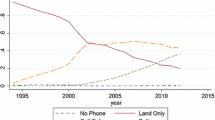Abstract
In this article, we estimate the price elasticities of demand for subscription and consumer switching costs for mobile telephony. We use a panel data of Portuguese consumers to estimate a series of multinomial and mixed logit models. The demand for subscription is found to be elastic and switching costs are large. We use the structural model to perform several policy exercises. Switching costs and brand preferences are shown to be important elements of the market structure of mobile telephony. Price mediated network effects seem to be relatively less important.
Similar content being viewed by others
References
Amante, A., & Vareda, J. (2010). Switching costs in the Portuguese telecoms sector: results. Portuguese Competition Authority, unpublished.
Ben-Akiva M., McFadden D. L., Train K. E. (1987) The demand for local telephone service: A fully discrete model of residential calling patterns and service choices. Rand Journal of Economics 18(1): 109–123
Chen, P.-Y., & Forman, C. (2003). Switching costs and network effects in the market for routers and switches. Net Institute Working article #03–03.
Epling, N. (2002). Price discrimination amid heterogeneous switching costs: A competitive tactic of the telephony resale fringe. Yale University, unpublished.
Farrell J., & Klemperer, P. (2007). Coordination and lock-in: Competition with switching costs and network effects. In M. Armstrong & R. Porter (Eds.), Handbook of industrial organization (pp. 1970–2056). North-Holland.
Goldfarb A. (2006) State dependence at internet portals. Journal of Economics and Management Strategy 15: 317–352
Grzybowski L. (2007) Estimating switching costs in mobile telephony in the UK. Journal of Industry, Competition and Trade 8(2): 113–132
Grzybowski L., Pereira P. (2007) Simulation of merger in mobile telephony in Portugal. Review of Industrial Organization 31(3): 205–220
Grzybowski L., Pereira P. (2008) Complementarity between calls and messages in mobile telephony. Information Economics and Policy 20(3): 279–287
Grzybowski L., Pereira P. (2009) The consumer loss of the minimum duration for mobile telephone calls. Telecommunications Policy 33(3–4): 200–206
Heckman J. (1981) Statistical models for discrete panel data. In: Manski C. F., McFadden D. (eds) Structural analysis of discrete data with econometric applications. The MIT Press, Cambridge, MA, pp 179–195
Heitfield E., Levy A. (2001) Parametric, semi-parametric and non-parametric models of telecommunications demand: An investigation of residential calling patterns. Information Economics and Policy 13(3): 311–329
Kim, J. (2006). Consumers’ dynamic switching decisions in the cellular service industry. NET Institute Working article #06–24.
Knittel C. (1997) Interstate long distance rates: Search costs, switching costs and market power. Review of Industrial Organization 12: 519–536
Kridel D., Rappoport P., Taylor L. (2002) IntraLATA long-distance demand: Carrier choice, usage demand and price elasticities. International Journal of Forecasting 18(4): 545–559
Lee J., Kim Y., Lee J. D., Park Y. (2006) Estimating the extent of potential competition in the Korean mobile telecommunications market: Switching costs and number portability. International Journal of Industrial Organization 24: 107–124
NERA (2003). Switching costs. A report prepared for the office of fair trading and the department of trade and industry. Economic Discussion Paper 5.
Rodini M., Ward M., Woroch G. (2003) Going mobile: Substitution between fixed and mobile access. Telecommunications Policy 27(5): 457–476
Shum M. (2004) Does advertising overcome brand loyalty? evidence from the breakfast-cereals market. Journal of Economics and Management Strategy 13(2): 241–272
Small K. A., Rosen H. S. (1981) Applied welfare economics with discrete choice models. Econometrica 49: 105–130
Train K. (2003) Discrete choice methods with simulation. Cambridge University Press, Cambridge, MA
Viard V. B. (2005) Do switching costs make markets more or less competitive?: The case of 800-number portability. RAND Journal of Economics 38(1): 146–163
Wooldridge J. M. (2005) Simple solutions to the initial conditions problem in dynamic, nonlinear panel data models with unobserved heterogeneity. Journal of Applied Econometrics 20: 39–54
Author information
Authors and Affiliations
Corresponding author
Rights and permissions
About this article
Cite this article
Grzybowski, L., Pereira, P. Subscription Choices and Switching Costs in Mobile Telephony. Rev Ind Organ 38, 23–42 (2011). https://doi.org/10.1007/s11151-011-9275-y
Published:
Issue Date:
DOI: https://doi.org/10.1007/s11151-011-9275-y



